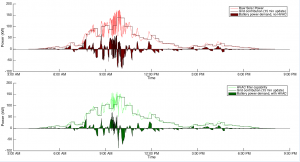Dynamic Energy Management Needs in Energy Efficient Buildings Imposed by Stochastic Solar Resources
Dynamic Energy Management Needs in Energy Efficient Buildings Imposed by Stochastic Solar Resources
Yue Cao with adviser P. Krein
This project examines various electrical and thermal energy generation, consumption, and storage components in solar-powered energy-efficient buildings. Dynamic management of such energy components is essential given the stochastic solar resources. Emphasis is put on power electronic HVAC (heating, ventilation, and air-conditioning) drives, which can act as an effective electric swing bus to mitigate solar power variability. In doing so, grid power flows become substantially more constant, reducing the need for fast grid resources or dedicated energy storage, including batteries. The concept is equivalent to using building thermal energy as virtual dynamic storage in support of power grid operation. The research defines a bandwidth over which such HVAC drives can operate. 18 months of solar data have been collected on sub-millisecond time scales as a basis to evaluate efficacy, determine solar frequency-domain content, and test the introduced filtering concept to model ideal power compensation. A practical band-pass filter is realized that provides 1) lower frequency bounds such that the building maintains consistent room temperature via the HVAC system, and 2) upper frequency bounds that ensure commanded HVAC fan speeds do not update arbitrarily fast to avoid acoustic discomfort to occupants. The lower HVAC update frequency limit appears to be about 1 mHz (inverse of 15 min) and seems to limit temperature variations in occupied spaces while reducing long-term on-site thermal energy storage needs. The higher update frequency limit in the range of about 0.1 Hz (inverse of 10 s), combined with ramp-rate and acoustic limits, lets a fan respond without generating annoying noise and reduces short-term on-site electrical energy storage needs. Figure 36 displays this implementation control. The process has been demonstrated by solar-data frequency-domain analysis and system-level electrical and thermal interaction modeling as well as a small-scale fan-drive experiment. A full-scale multiple-day simulation case study
has provided insight on potential grid-side and storage-related benefits. Figure 37 (top) depicts the conventional scenario for which a large amount of stochastic solar energy must be regulated by the grid or require substantial external storage. The situation in Fig. 37 (bottom) is much improved with assistance from the building thermal inertia via HVAC filtering. Practical solar energy filtering capability by the HVAC system varies with multiple factors including installed solar capacity, regional weather pattern, and building functionality and usage. This research is supported by the Grainger Center for Electric Machinery and Electromechanics.

